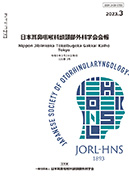Volume 126, Issue 3
Displaying 1-14 of 14 articles from this issue
- |<
- <
- 1
- >
- >|
Review article
-
2023 Volume 126 Issue 3 Pages 181-184
Published: March 20, 2023
Released on J-STAGE: April 01, 2023
Download PDF (1166K) -
Article type: review-article
2023 Volume 126 Issue 3 Pages 185-188
Published: March 20, 2023
Released on J-STAGE: April 01, 2023
Download PDF (307K) -
Article type: review-article
2023 Volume 126 Issue 3 Pages 189-193
Published: March 20, 2023
Released on J-STAGE: April 01, 2023
Download PDF (3153K)
Original Article
-
Article type: Original article
2023 Volume 126 Issue 3 Pages 194-199
Published: March 20, 2023
Released on J-STAGE: April 01, 2023
Download PDF (550K) -
Article type: Original article
2023 Volume 126 Issue 3 Pages 200-207
Published: March 20, 2023
Released on J-STAGE: April 01, 2023
Download PDF (1534K) -
Article type: Original article
2023 Volume 126 Issue 3 Pages 208-216
Published: March 20, 2023
Released on J-STAGE: April 01, 2023
Download PDF (669K) -
Article type: case-report
2023 Volume 126 Issue 3 Pages 217-223
Published: March 20, 2023
Released on J-STAGE: April 01, 2023
Download PDF (930K) -
2023 Volume 126 Issue 3 Pages 224-229
Published: March 20, 2023
Released on J-STAGE: April 01, 2023
Download PDF (1292K)
Training lecture
-
2023 Volume 126 Issue 3 Pages 232-235
Published: March 20, 2023
Released on J-STAGE: April 01, 2023
Download PDF (362K)
Skill up lecture
-
2023 Volume 126 Issue 3 Pages 236-238
Published: March 20, 2023
Released on J-STAGE: April 01, 2023
Download PDF (329K)
-
2023 Volume 126 Issue 3 Pages 239-240
Published: March 20, 2023
Released on J-STAGE: April 01, 2023
Download PDF (890K)
ANL Secondary Publication
-
2023 Volume 126 Issue 3 Pages 243-244
Published: March 20, 2023
Released on J-STAGE: April 01, 2023
Download PDF (193K) -
2023 Volume 126 Issue 3 Pages 245-247
Published: March 20, 2023
Released on J-STAGE: April 01, 2023
Download PDF (1966K) -
2023 Volume 126 Issue 3 Pages 248-250
Published: March 20, 2023
Released on J-STAGE: April 01, 2023
Download PDF (348K)
- |<
- <
- 1
- >
- >|
